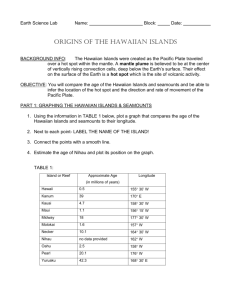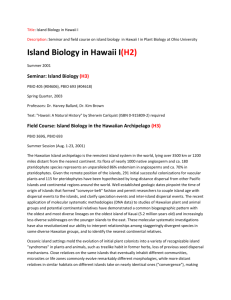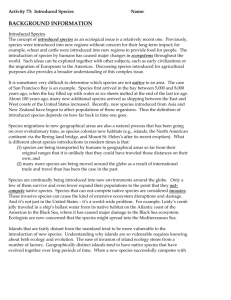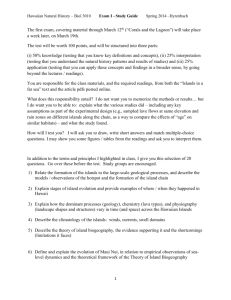Seminar and field course
advertisement
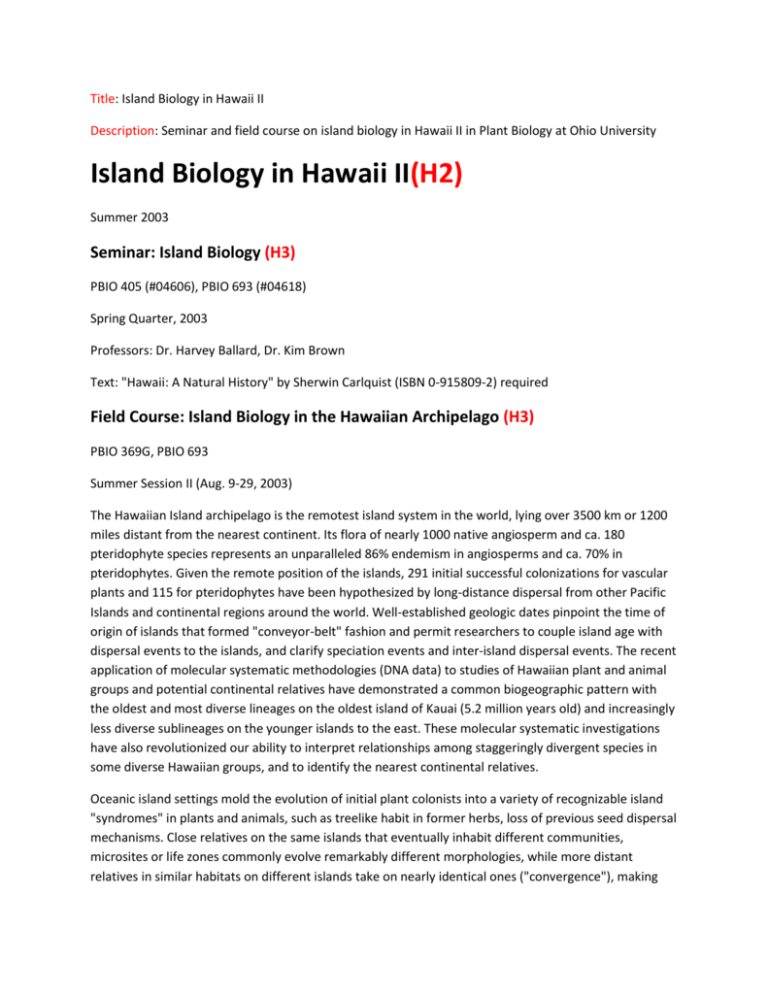
Title: Island Biology in Hawaii II Description: Seminar and field course on island biology in Hawaii II in Plant Biology at Ohio University Island Biology in Hawaii II(H2) Summer 2003 Seminar: Island Biology (H3) PBIO 405 (#04606), PBIO 693 (#04618) Spring Quarter, 2003 Professors: Dr. Harvey Ballard, Dr. Kim Brown Text: "Hawaii: A Natural History" by Sherwin Carlquist (ISBN 0-915809-2) required Field Course: Island Biology in the Hawaiian Archipelago (H3) PBIO 369G, PBIO 693 Summer Session II (Aug. 9-29, 2003) The Hawaiian Island archipelago is the remotest island system in the world, lying over 3500 km or 1200 miles distant from the nearest continent. Its flora of nearly 1000 native angiosperm and ca. 180 pteridophyte species represents an unparalleled 86% endemism in angiosperms and ca. 70% in pteridophytes. Given the remote position of the islands, 291 initial successful colonizations for vascular plants and 115 for pteridophytes have been hypothesized by long-distance dispersal from other Pacific Islands and continental regions around the world. Well-established geologic dates pinpoint the time of origin of islands that formed "conveyor-belt" fashion and permit researchers to couple island age with dispersal events to the islands, and clarify speciation events and inter-island dispersal events. The recent application of molecular systematic methodologies (DNA data) to studies of Hawaiian plant and animal groups and potential continental relatives have demonstrated a common biogeographic pattern with the oldest and most diverse lineages on the oldest island of Kauai (5.2 million years old) and increasingly less diverse sublineages on the younger islands to the east. These molecular systematic investigations have also revolutionized our ability to interpret relationships among staggeringly divergent species in some diverse Hawaiian groups, and to identify the nearest continental relatives. Oceanic island settings mold the evolution of initial plant colonists into a variety of recognizable island "syndromes" in plants and animals, such as treelike habit in former herbs, loss of previous seed dispersal mechanisms. Close relatives on the same islands that eventually inhabit different communities, microsites or life zones commonly evolve remarkably different morphologies, while more distant relatives in similar habitats on different islands take on nearly identical ones ("convergence"), making the interpretation of actual evolutionary relationships by gross morphology impossible in many instances. In addition, most oceanic island species are, by nature, typically limited in range and rare in distribution where they have evolved, and in the course of human history have been driven to the brink of extinction or beyond it through heavy fragmentation of their natural habitats, degradation of microhabitats by exotic plants and animals, and secondarily by reduction of plant populations and consequent genetic erosion. Oceanic islands such as the Hawaiian archipelago are lush laboratories of living evolutionary endproducts, often fantastically beautiful and at other times utterly bizarre, and usually irreconcilable considering a particular group's hypothesized continental ancestors. Oceanic islands thus provide one of the world's most exciting areas of scientific exploration into plant diversity, evolution and conservation. Since relatively little empirical scientific research has yet been published into the processes underlying plant speciation, studies on island plants can provide new insights into diversification of plant life on earth. Dr. Kim Brown has conducted studies on the ecophysiological responses and landscape-level processes of forest systems elsewhere around the world, including New Zealand, and Dr. Harvey Ballard has pursued research with colleagues into the biogeographic origins and adaptive radiation of the Hawaiian violets. A broadly designed, ecological theme course of "Island Biology" will be taught for the second time in the Hawaiian Islands. In addition to exposing students to the ecology and evolution of oceanic island plant life, geologic history and human cultures now inhabiting the islands, field research will focus on characterizing the floristic composition of, and biotic and abiotic parameters influencing, middle and high-altitude natural communities on the three islands. Where they occur along our study transects, we will also sample and study populations of Hawaiian violet species (many of which are endangered) that are restricted to particular communities, in order to gain an understanding of ecological isolation mechanisms maintaining the evolutionary integrity of the violet species despite frequent hybridization, as well as the species' fundamental ecological niches. The Islands: The oldest island (5.1 million years old), Kauai, is lushly blanketed with vegetation and is more lower in elevation than nearby Oahu to the east and the newest "Big Island" of Hawaii at the east end of the archipelago, owing to longer periods of erosion following its volcanic birth. Nevertheless, erosion on Kauai has left spectacular knife-edged ridges radiating down from the central highlands, making Kauai perhaps the most visually striking of all the islands. Numerous valleys are interspersed between the ridges and provide many plants and animals with unusual microsites, resulting in increased rates of evolution and lots of endemic species in each particular valley, and each with their lovely and biotically diverse streams and waterfalls. Kauai has its famous Waimea Canyon ("the Grand Canyon of the Pacific"), the result of a fault along one of the ridges, and the road heading up to the central and extensive Alakai Swamp and Kokee State Park at the top of the island travels along the bottom of this amazing geologic wonder. Near the summit of the island is a vast perched plateau with open bogs and fragments of swamp forest. The "Global Studies" course participants will spend the week hunting for violet populations and conducting field systematic studies of them, as well as taking soil temperature and moisture data, will collect samples for subsequent testing of nutrients and pH, and will make ecological/ecophysiological measurements (including light availability), all of which reflect the evolution of divergent physiological tolerances (and habitat specificity) among the violet species. We will also compare generic composition of associated species in different violet habitats by sampling the vegetation around each population. For part of our stay we will lodge in cabins in Kokee State Park, right in the rich forest bordering the Alakai. Oahu, the second oldest island (3.5 million years old), is also strongly vegetated particularly in the mountain ranges but harbors areas of sparsely clothed, windswept cliffs in the northwest portion. Oahu consists of two separate islands with their own mountain ranges which eventually merged into one larger island. We will land in Honolulu, on this island, and will make this our first week-long study site. We will be hiking into rugged, difficult-to-access highland areas to continue our hunts for rare violets (some of which occupy alpine openings), and will compare ecological and ecophysiological data and associated species from these violets with data obtained from violets on Kauai, during the second week, on Oahu. A collection of smaller, lower-elevation islands in the center of the archipelago, called the "Maui-Nui" complex (1.9-1.2 million years old altogether), is made up of Molokai on the northwest end, Maui on the northeast end and Lanai to the south. These islands are mostly composed of lowland and mid-elevation forest, with the barren and fantastically beautiful Haleakala Volcano jutting abruptly out of the eastern end of Maui. The "Friendly Island" of Maui, the easternmost and largest of the islands comprising the Maui Nui complex, is much younger than Kaui and Oahu at about 1.3 million years ago. The landscape is partially eroded, moreso in West Maui which is lower in elevation and geologically older than East Maui; the two halves are connected by a low narrow isthmus. The island itself is the remains, together with Molokai to the west and Lanai to the south, of the larger, earlier island of "Maui Nui" that blew its top, leaving three larger fragments presently separated by narrow ocean channels. The western half of Maui has interesting mid-elevation bogs harboring one species of violet found only in the Maui Nui complex and (if it's the same species) also on the Big Island of Hawaii to the east. But the most spectacular portion of Maui is the eastern half, represented by the "barren" volcanic cone and crater of Haleakala. Many very rare endemic species, of all types, are known from the slopes and the caldera of Haleakala, and the lower forest vegetation, as well as the higher lava flows and sparsely vegetated rubble, are fascinating. We will visit this island after our week on Kauai, staying at an area around the isthmus so that we can easily access both halves of the island. Thus, during the field course, we will spend slightly more than one week each on Oahu and Kauai, and just less than one week on Maui, in that order. Purpose of the Course: To teach students about the vegetational ecology, flora, evolutionary processes and adaptations of plants, their ecophysiological responses to local and regional environmental conditions, and human-environment interactions on oceanic islands, exploring aspects covered in the Spring quarter introductory seminar. Field studies will cover both terrestrial ecology and systematics. Stress will be placed on identification of common genera and families of flowering plants, observations of vegetation structure, measurements of important biotic and abiotic ecological parameters and physiological traits, note of characteristic life forms and recurrent adaptations, and general climatic conditions maintaining the vegetation. Passive note will also be made regarding agricultural practices, economically useful plants, human impacts and regional conservation efforts. Format: This intensive field course spans three weeks (9-29 August, 2003) of the Summer II session. We will fly into Oahu and spend just over a week on that island, then fly to Kauai, the oldest island, and spend a little more than one week there, and finally fly to Maui for a few days to finish our course, before heading back to Honolulu and then to Columbus. The class will use state park and/or inexpensive hostel/hotel accommodations on each island as "base camps" for several days of extended hikes into nearby natural communities and surrounding lands. At each study area, day hikes will stress observations on community structure, life forms, evolutionary adaptations to the oceanic island environment, identification of major plant genera and families, ecological factors maintaining communities, physiological responses of individual species in their respective niches, and secondarily will note uses of economically important crops and agricultural practices, human impacts, and conservation efforts. Representative plants will be brought back to our lodgings for evening study. Suppertime discussions will review each day's observations, data and study materials, and events. Communal evening study sessions will focus on reviews of plant identifications and distinctions, and illustration of characteristic plants, and will include processing of study materials such as leaf or soil samples. Students are also expected to find time to record significant field observations and personal reflections in their daily journal. In the course of the field research, students will utilize previous and newly developed field identification skills, prepare representative plant specimens as vouchers, apply standard ecological sampling techniques for vegetation, record soil and environmental measurements, preserve plant tissue of populations and species for laboratory molecular genetic analysis, read maps, and use a Global Positioning System to obtain latitude, longitude and elevation. Certain Hawaiian botanists will accompany us during different portions of the field course. The course integrates three disparate objectives, in this priority: (1) train students in field research methods by engaging them in actual ecological and systematic investigations on Hawaiian plants (notably, violets as model organisms); (2) educate students in common genera and families of Hawaiian vascular plants; (3) expose students to the natural (and anthropogenetic) vegetation of Hawaii, climatic influences that maintain these, and adaptations evolved in the flora to permit plants to survive in the oceanic island environment; and (4) provide students with a field-based learning environment outside of Ohio and the contiguous United States. Students should recognize that implementation of the first objective, a fully developed research project, provides the framework upon which the other objectives are based. This will require demanding field days seeking and recording observations on study populations. It also raises the expectation of a certain degree of tedium in the field surveys, because of the need for data from multiple populations (=replicates) of the same species, and due to the repetitive nature of ecological measurements, as well as of population sampling. Processing of soil samples and plant study materials is also an integral component of the research process. Enrollment/Credits: 6-8 (possibly up to 10) students; 6 credit hours, conducted in Summer II session. Eligibility: Open to all undergrad natural sciences majors meeting the prerequisites, and PBIO/BIOS/MSES grad students; eligibility must be approved in the Winter quarter by the instructors. Prerequisites: PBIO 111, PBIO 405/693 (Island Biology Spring quarter seminar), additional mandatory briefing sessions concurrent with the seminar, at least sophomore standing in Spring, and instructor permission through an interview; Plant Systematics (PBIO 309/509) or Plant Ecology (PBIO 425/525) are strongly recommended Evaluations of Student Progress Two field examinations (200 points, 100 points each), completed during field course Participation in daily field lessons and research project, and in evening review of site observations, research data and plants identified (100 points); accomplished during field course Maintenance of a daily journal with field observations, plant illustrations and identifying features, and personal experiences (100 points); journal and evaluations for the field course will be handed at the very end of the course, as students depart for Columbus. Voluntary debriefing and webpage creation sessions will take place after the course is completed, in the fall quarter. Field Course Itinerary and Content Date, Location/Lodging, Activity/Focus Summer Session II (Aug. 9-29) Aug. 9, Fly to Honolulu on Oahu; lodging (8/9-13) at Waikiki Beachside Hostel, Waikiki Aug. 10, Waikiki; Honolulu Botanical garden; Bishop Museum tour; evening luau! Aug. 11-13, Day trips in Koolau Mtn Range in E Oahu; Field studies: mid- and high-elevation forest and mountaintop communities; evening lecture (8/11) by Hampton Carson Aug. 14-15, Drive to Kapolei; lodging (Aug. 14-15) at Camp Timberline, Kapolei; day trips throughout Waianae Mountain Range in W Oahu; Field studies: mid- and high-elevation forest and mountaintop communities; World War II bunkers Aug. 16, Drive back to Waikiki in morning; lodging (Aug. 16) at Waikiki Beachside Hostel; DAY OFF Aug. 17, Fly to Lihue, Kauai; half-day trip to Hanalei in N Kauai; lodging (Aug. 17) at Kapaa Beach House, Kapaa; Field studies: shoreline communities Aug. 18-21, Drive to Alakai Swamp; lodging (Aug. 18-21) at Kokee State Park Lodge; day trips throughout Alakai Swamp; Kokee Museum tour; field studies: high-elevation forests, swamps and bogs; EXAM #1 in afternoon (Aug. 21) Aug. 22, Drive to Kapaa; lodging (Aug. 22-23) at Kapaa Beach House, Kapaa; National Tropical Bot Garden tour; field studies: coastal communities Aug. 23, Kapaa; DAY OFF Aug. 24, Fly to Kahului on Maui; drive to Hawi; lodging (Aug. 24-27) at Banana Bungalow Maui Hostel, Wailuku Aug. 25-26, Day trips in western Maui; Bog violets; field studies: coastal and lava communities; EXAM #2 in afternoon (Aug. 26) Aug. 27, Wailuku; DAY OFF Aug. 28-29, Flight to Honolulu/Columbus Texts and Other Resources: Required text—Sohmer, S. H. and R. Gustafson. 1996. Plants and flowers of Hawai'i. University of Hawaii Press, Honolulu, Hawaii. Hand lens [available in local university bookstores] Expenses for the Field Course Tuition, 6 undergraduate credit hours (or may be included as part of comprehensive fee if full-time student in Summer; students can take other courses in Summer I to obtain full-time status). Financial aid can be applied to field course expenses and tuition, with advance planning. A $150 deposit must be paid, together with a signed financial commitment form, by the end of the fifth week of the preceding Spring quarter. The remainder of the Program Fee will be billed by the Bursar at the end of Spring quarter after students are pre-registered by the instructors. Domestic expenses paid out of pocket before summer course--$50 Textbook—ca. $35 Hand lens—ca. $15 Program Fee billed by Bursar--$1,925 Airfare—$880 Ground transportation (2 mini-vans, gas) —$260 Lodging—$685 Course-related excursions, botanical garden and national park entrance fees--$100 Recommended food money ($25/day x 21 days), brought by student—$525 Total cost for field course (excluding tuition or spending money) = $2,450 [NOTE: Remember to bring your food money, plus additional "spending money" for souvenirs, internet, postage, laundry, "evenings out"—ca. $200-300 ] Prepared by Harvey Ballard; last revised 18 May, 2003

